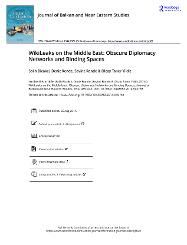| dc.contributor.author | Bıçakcı, Salih | |
| dc.contributor.author | Rende, Deniz | |
| dc.contributor.author | Rende, Sevinc | |
| dc.contributor.author | Yıldız, Olcay Taner | |
| dc.date.accessioned | 2019-06-27T08:02:47Z | |
| dc.date.available | 2019-06-27T08:02:47Z | |
| dc.date.issued | 2014 | |
| dc.identifier.issn | 1944-8953 | en_US |
| dc.identifier.issn | 1944-8961 | en_US |
| dc.identifier.uri | https://hdl.handle.net/20.500.12469/684 | |
| dc.identifier.uri | https://doi.org/10.1080/19448953.2014.940763 | |
| dc.description.abstract | In this paper we explore the flow of information regarding strategic Middle Eastern countries in the WikiLeaks 'diplomatic cables' by applying data-mining techniques to construct directed networks. The results show that between 2002 and 2009 US diplomatic communication related to these countries increased although with notable variation in flow patterns. We discuss the value of a visual display of diplomatic communication patterns in understanding the decentralized nature of information gathering on regional foreign policy issues. | en_US] |
| dc.language.iso | eng | en_US |
| dc.publisher | Routledge Journals Taylor & Francis Ltd | en_US |
| dc.rights | info:eu-repo/semantics/openAccess | en_US |
| dc.subject | N/A | en_US |
| dc.title | WikiLeaks on the Middle East: Obscure Diplomacy Networks and Binding Spaces | en_US |
| dc.type | article | en_US |
| dc.identifier.startpage | 459 | en_US |
| dc.identifier.endpage | 473 | |
| dc.relation.journal | Journal of Balkan and Near Eastern Studies | en_US |
| dc.identifier.issue | 4 | |
| dc.identifier.volume | 16 | en_US |
| dc.department | Fakülteler, İktisadi, İdari ve Sosyal Bilimler Fakültesi, Uluslararası İlişkiler Bölümü | en_US |
| dc.identifier.wos | WOS:000344246200005 | en_US |
| dc.identifier.doi | 10.1080/19448953.2014.940763 | en_US |
| dc.identifier.scopus | 2-s2.0-85028146795 | en_US |
| dc.institutionauthor | Bıçakcı, Salih | en_US |
| dc.relation.publicationcategory | Makale - Uluslararası Hakemli Dergi - Kurum Öğretim Elemanı | en_US |
















